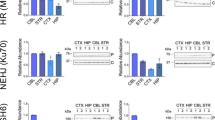Abstract
Background
Double-strand DNA breaks with blunt ends represent the most serious type of DNA damage, and cannot be efficiently repaired by cells. They are generated in apoptosis or necrosis and are absent in normal or transiently damaged cells. Consequently, they can be used as a molecular marker of irreparable cellular damage. We evaluated the effects of focal brain ischemia using selective labeling of blunt-ended DNA breaks as a marker of irreversible tissue damage. A new approach permitting such analysis in situ is introduced.
Materials and Methods
Rat brain sections taken 6, 24, 48 and 72 hr after the onset of focal brain ischemia were used. Double-strand DNA breaks were detected directly in the tissue sections via ligation of blunt-ended hairpin-shaped oligonucleotide probes. The probes were attached to the ends of the breaks by T4 DNA ligase. Conventional cresyl violet co-staining and terminal transferase based labeling (TUNEL) were employed to analyze the distribution of labeled cells.
Results
Double-strand blunt-ended DNA breaks rapidly accumulate in brain cells after focal brain ischemia. At 24 hr, they concentrate in the peripheral areas of stroke, which are prone to ischemia-reoxygenation. By 48–72 hr, this type of DNA damage spreads inward, covering the internal areas of the ischemic zone.
Conclusions
Selective labeling of blunt-ended DNA breaks delineates the dynamics of stroke-induced irreversible DNA damage and provides highly specific detection of brain cells with irreparable DNA injury. It can be used for comparing the efficiency of various anti-ischemic drugs, particularly those that target DNA damage, as well as for monitoring stroke-induced damage.




Similar content being viewed by others
References
Didenko VV, Wang X, Yang L, Hornsby PJ. (1999) DNA damage and p21WAF1/CIP1/SDI1 in experimental injury of the rat adrenal cortex and trauma-associated damage of the human adrenal cortex. J. Pathol. 189: 119–126.
Lips J, Kaina B. (2001) DNA double-strand breaks trigger apoptosis in p53-deficient fibroblasts. Carcinogenesis 22: 579–585.
Lieber MR. (1998) Pathological and physiological doublestrand breaks: roles in cancer, aging, and the immune system. Am. J. Pathol. 153: 1323′1332.
Didenko VV, Hornsby PJ. (1996) Presence of double-strand breaks with single-base 3′ overhangs in cells undergoing apoptosis but not necrosis. J. Cell Biol. 135: 1369–1376.
Al-Lamki RS, Skepper JN, Loke YW, et al. (1998) Apoptosis in the early human placental bed and its discrimination from necrosis using the in-situ DNA ligation technique. Hum. Reprod. 13: 3511–3519.
Al-Lamki RA, Skepper JN, Loke YW, et al. (1998) Apoptosis in the early human placental bed and its discrimination from necrosis using the in situ DNA ligation technique. Hum. Reprod. 13: 3511–3519.
Morita-Fujimura Y, Fujimura M, Yoshimoto T, Chan PH. (2001) Superoxide during reperfusion contributes to caspase-8 expression and apoptosis after transient focal stroke. Stroke 32: 2356–2361.
Moroni F, Meli E, Peruginelli F, et al. (2001) Poly(ADP-ribose) polymerase inhibitors attenuate necrotic but not apoptotic neuronal death in experimental models of cerebral ischemia. Cell Death Differ. 8: 921–932.
Fukuda T, Wang H, Nakanishi H, et al. (1999) Novel non-apoptotic morphological changes in neurons of the mouse hippocampus following transient hypoxic-ischemia. Neurosci. Res. 33: 49–55.
Didenko VV, Tunstead JR, Hornsby PJ. (1998) Biotin-labeled hairpin oligonucleotides: probes to detect double-strand breaks in DNA in apoptotic cells. Am. J. Pathol. 152: 897–902.
Didenko VV, Boudreaux DJ, Baskin DS. (1999) Substantial background reduction in ligase-based apoptosis detection using newly designed hairpin oligonucleotide probes. Biotechniques 27: 1130–1132.
Walker PR, Leblanc J, Carson C, et al. (1999) Neither caspase-3 nor DNA fragmentation factor is required for high molecular weight DNA degradation in apoptosis. Ann. N.Y. Acad. Sci. 887: 48–59.
Kontos HA. (2001) Oxygen radicals in cerebral ischemia: the 2001 willis lecture. Stroke 32: 2712–2716.
Li X, Darzynkiewicz Z. (1995) Labelling DNA strand breaks with BrdUTP. Detection of apoptosis and cell proliferation. Cell Prolif. 28: 571–579.
Grasl-Kraupp B, Ruttkay-Nedecky B, Koudelka H, et al. (1995) In situ detection of fragmented DNA (TUNEL assay) fails to discriminate among apoptosis, necrosis, and autolytic cell death: a cautionary note. Hepatology 21: 1465–1468.
Sloop GD, Roa JC, Delgado AG, et al. (1999) Histologic sectioning produces TUNEL reactivity. A potential cause of false-positive staining. Arch. Pathol. Lab. Med. 123: 529–532.
Dikomey E, Lorenzen J. (1993) Saturated and unsaturated repair of DNA strand breaks in CHO cells after X-irradiation with doses ranging from 3 to 90 Gy. Int. J. Radiat. Biol. 64: 659–667.
Velier JJ, Ellison JA, Kikly KK, et al. (1999) Caspase-8 and caspase-3 are expressed by different populations of cortical neurons undergoing delayed cell death after focal stroke in the rat. J. Neurosci. 1: 5932–5941.
Martin LJ, Al-Abdulla NA, Brambrink AM, et al. (1998) Neurodegeneration in excitotoxicity, global cerebral ischemia, and target deprivation: a perspective on the contributions of apoptosis and necrosis. Brain Res. Bull. 46: 281–309.
Acknowledgments
This research was supported by grant R01 CA78912 from the National Cancer Institute, National Institutes of Health (D.S.B.), by grant 004949-054 from the Texas Higher Education Coordinating Board (D.S.B. and V.V.D.), and by grants from DeBakey Medical Foundation (V.V.D.), Baylor College of Medicine (V.V.D.), The Taub Foundation, The Henry J.N. Taub Fund for Neurosurgical Research, The George A. Robinson, IV Foundation, The Blanche Greene Estate Fund of The Pauline Sterne Wolff Memorial Foundation, and The Seigo Arai and Koppelman Funds of The Neurological Research Foundation (D.S.B.).
Author information
Authors and Affiliations
Corresponding author
Rights and permissions
About this article
Cite this article
Didenko, V.V., Ngo, H., Minchew, C.L. et al. Visualization of Irreparable Ischemic Damage in Brain by Selective Labeling of Double-Strand Blunt-Ended DNA Breaks. Mol Med 8, 818–823 (2002). https://doi.org/10.1007/BF03402086
Accepted:
Published:
Issue Date:
DOI: https://doi.org/10.1007/BF03402086




